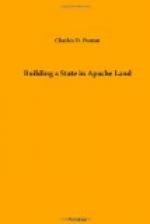As the geography of the country was not well understood at the time, it was not presumably known to the makers of the treaty that the boundary line would include both banks of the Colorado River in the American boundary, but it does. By a curious turn in the Colorado River, after passing through the gorge between Fort Yuma and the opposite bank, the boundary line of the United States includes both banks of the River to the crossing at Pilot Knob, nearly nine miles. When the State of California was organized in 1850, the constitution adopted the boundary line of the State, and consequently assumed jurisdiction over the slip of land on the bank of the Colorado opposite Fort Yuma. When Fort Yuma was established, the commanding officer established a military reservation, including both banks of the Colorado River at its junction with the Gila.
The boundary line between Mexico and the United States, under the treaty of 1848, was run in 1850, and monuments erected on the southern bank of the Colorado, to indicate the possession of the United States.
While we were encamped on the banks of the Colorado River, in the hot month of July, 1854, we concluded to locate a town-site on the slip of land opposite Fort Yuma, and as we were well provided with treaties, maps, surveying instruments, and stationery, there was not much difficulty in making the location. The actual survey showed 936 acres within the slip, and this was quite large enough for a “town-site.” A town-site is generally the first evidence of American civilization.
After locating the town-site at Yuma there was nothing to do but to cross the desert from the Colorado River to San Diego. We made the journey on mules, with extraordinary discomfort. At San Diego we were as much rejoiced as the followers of Xenophon to see the sea.
The town-site was duly registered in San Diego, which could not have been done if both banks of the Colorado just below its junction with the Gila had not been recognized as being within the jurisdiction of the State of California. The county of San Diego collected taxes there for many years. After the organization of the Territory of Arizona in 1863, Arizona assumed jurisdiction over the slip, and built a prison there. Congress subsequently made a grant of land included in the slip to the “Village of Yuma,” so that it is a mere question of jurisdiction, not involving the validity of any titles. The question of jurisdiction still remains unsettled, as it requires both an Act of Congress and Act of the State Legislature to change the boundaries of a sovereign State.
The town-site of Yuma has grown slowly, but there will be a town there as long as the two rivers flow. The Southern Pacific Railroad was completed years ago, and forms the great artery of commerce. Immigration enterprises of great magnitude have been undertaken with the waters of the Colorado River. The river washes fully three hundred thousand square miles, and furnishes a water power in the cataracts of the Grand Canon only second to Niagara.




